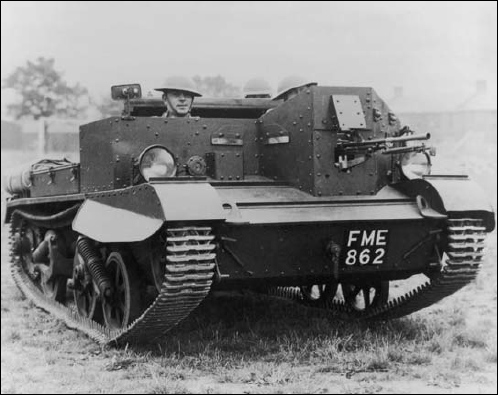

INTRODUCTION
THE MACHINE GUN CARRIERS
THE BREN GUN CARRIER
A TASTE OF WAR
THE UNIVERSAL CARRIER
NORTH AMERICAN PRODUCTION
WITH THE INFANTRY
FIREPOWER
POST-WAR ACTIVITIES
BIBLIOGRAPHY
COLOUR PLATE COMMENTARY
The Universal Carrier is typically British – peculiarly British some might say: a compromise, neither one thing nor the other. Designed for a role that it never really fulfilled, it was adapted to dozens of others for which it was never entirely suited and was still in service, in vast numbers, long after it should have been pensioned off. Granted, it was also copied by the Australian, New Zealand and Canadian armies, but presumably on the assumption that the British knew what they were doing in the first place. It saw service all over the world, with just about every army that took part in the Second World War and some that did not. It is regarded with sentimental affection by those who used it and yet it is still referred to by everyone, quite incorrectly, as the Bren Gun Carrier.
Tracked carriers were nothing new – a simple version had appeared towards the end of the Great War – but the origins of the Universal Carrier may be traced to the Ford T-powered Carden-Loyd machines of the mid-twenties, and specifically the definitive Mark VI model of 1927. When the Carden-Loyd Company was taken over by Vickers-Armstrongs in 1928 the tiny machine-gun carrier became a major component of the British Army and a considerable export success. Yet for all that it was cramped, vulnerable and unreliable with just the one merit – it was cheap.
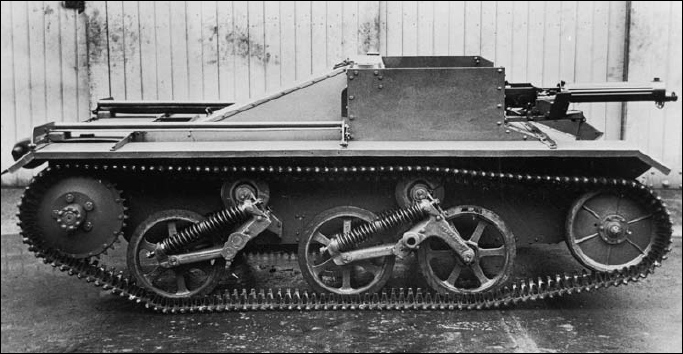
Prototype carrier VAD50 in its original form with the coil spring on the leading bogie sloping backwards. Like the earlier Carden-Loyds, this prototype carrier had left-hand drive and a machine gun elevated by the gunner’s feet. The backrests on the track guards are folded down.
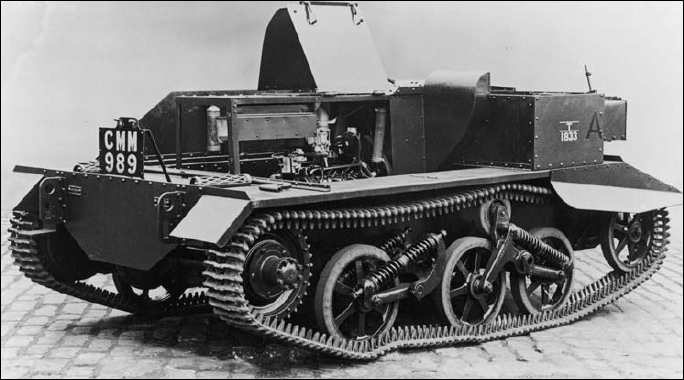
Machine Gun Carrier No. 1 Mark I viewed from the rear with the engine panels raised to reveal the Ford V8. The rear compartment is wide open on this side but enclosed by a vertical panel on the other. T1833 (numbered as a Tank in the War Office system then in use) was later converted to become the prototype Mortar Carrier.
Other lines of development, stemming from the Carden-Loyd, were a family of light tanks and a range of artillery tractors known as Dragons, which, on account of their greater weight, required bigger engines and a more substantial and flexible suspension system devised by the Horstman company. Most Dragons employed a Meadows six-cylinder petrol engine and in addition to their use by the British Army they enjoyed considerable success on the export market. However, they were expensive, specialized machines, and in an effort to produce something cheaper Vickers-Armstrongs launched an interesting new vehicle with the development number D50, in 1934.
The vehicle was delivered to the Mechanisation Experimental Establishment (MEE) at Farnborough and tested in 1935. Outwardly it did not look very exciting. The body was limited to a two-man compartment at the front, while narrow seats, running lengthways along the track guards at the rear, would accommodate the rest of the crew. Mechanically it was equally simple. The engine, located centrally in the body, was the standard commercial Ford V-8 linked by a four-speed and reverse gearbox, also by Ford, to the same company’s standard truck rear axle at the back. The suspension was similar to that used on contemporary Light Dragons, the so-called Horstman slow-motion system that Vickers referred to as their ‘double spring’ type; however, in this case it amounted to just one and a half bogies per side. What made the design outstanding was the steering system.
One problem that had plagued the Carden-Loyds, and the Dragons, was a phenomenon known as reverse steering. This could result in a vehicle that was travelling downhill actually turning the opposite way from that intended, sometimes with disastrous results. It was a common failing with clutch and brake steering, although experienced drivers could use it to their advantage. The new system, which was probably the brainchild of Sir John Carden, Vickers’ chief AFV designer, and of his deputy Leslie Little, was ingenious and relatively foolproof. It was so arranged that the foremost suspension units on each side shared a common axle, a strong tubular shaft that ran across the floor of the vehicle and was capable of sliding sideways to a limited extent. Activated by a steering wheel, it had the effect of displacing both bogies sideways, bending the tracks and causing the vehicle to steer, without braking or skidding, for large radius turns. Skid steering could be brought into play for tighter turns by giving a harder twist to the steering wheel; this applied a brake to one side of the differential or the other and so, since no clutch was involved, there was no risk of reverse steering.
Another advantage sometimes put forward for this system was that, by offsetting the suspension to some extent, it would allow the vehicle to run straight along a cambered road without continually trying to work its way into the gutter. The suspension system also gave a good ride across country, while the short pitch, manganese-iron tracks were hard-wearing and free-running at speed. MEE tested D50 as a light artillery tractor and a carrier for the Vickers machine gun. In the former role it evolved into the Dragon, Light, Mark III, which does not concern us here, and in the latter into an experimental machine-gun carrier, which does. The original D50 vehicle was never purchased for military service. Its suspension was subsequently modified and, later still, it appeared in an exotic camouflage scheme, mounting a Vickers 40mm anti-tank/anti-aircraft gun and offered for export.
Within a year Vickers-Armstrongs supplied a second vehicle, this time to a War Office contract, which was referred to as an Experimental Armoured Machine Gun Carrier. Identical to D50 in terms of engine, transmission and suspension, it was, more logically for a British vehicle, given a right-hand drive layout. It still retained the rear seats above the track guards but these were now provided with folding backrests and in the upright position offered seating for four men, two per side. To the left of the driver was the sixth crew member, who operated the Vickers machine gun, but stowage was also provided for six service rifles for the entire crew.
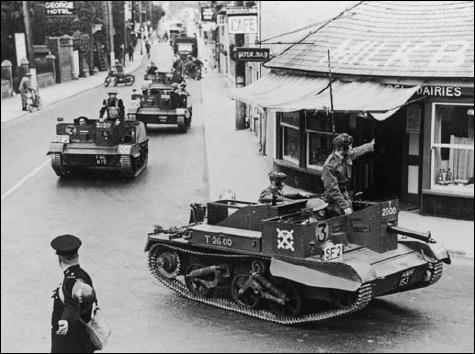
Not all of the Machine Gun Carriers No. 2 Mark II were rebuilt as Bren Gun Carriers when the war began. Here T2600, an early Thornycroft-built example, still features a Vickers gun in the enlarged gunner’s compartment as it leads a column of carriers through Amesbury, Wiltshire. The markings suggest that they are playing the part of enemy vehicles in an exercise.
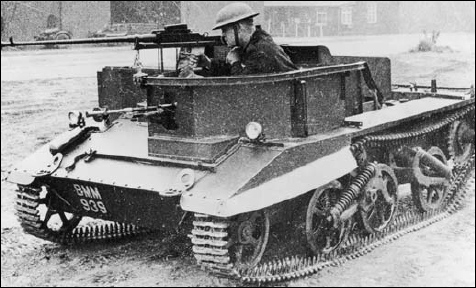
The only known photograph of the prototype BMM939 modified into the role of General Scout Vehicle. The gunner’s compartment is much enlarged, with a Bren gun in the aperture and Boys anti-tank rifle on a sliding rail around the lip.
The vehicle was designed in line with recommendations published in 1935 entitled Notes on Infantry Experiments, which called for a carrier with 6mm armour protection, small and inconspicuous but capable of carrying a Vickers gun that could be fired either from the vehicle or, dismounted with its crew, from a tripod. It arrived at MEE in December 1935 and was subsequently modified to other roles. Following trials of this vehicle, a contract for 13 more was issued to Vickers-Armstrongs in April 1936: these were designated Carrier, Machine Gun, No. 1 Mark I and at this stage it seems that the intended role had been settled. No seats were provided on the track guards but a small compartment, protected by a raised outer hull plate, was created on the left for a third crew member. Thus there is the driver, sitting front right, the machine-gunner to his left and the third man behind him. The machine-gun mounting appears to have been more substantial and often came fitted with an extra shield, all of which suggests that the intention was to carry and fight the weapon on the vehicle.
Seven of these vehicles were subsequently modified as prototypes for other roles and the first of them, the Carrier Machine Gun No. 2 Mark I, introduced a significant new feature. This was an enlarged gunner’s compartment at the front so that it stood out, like an angular bay, onto the glacis plate. It may have blocked the driver’s view to his left to some extent but it made it much easier for the gunner to handle his weapon and, with its raised upper section, increased his protection. Armour on production machines was 12mm thick.
The Carrier, No. 2 Mark I was the first example to enter mass production, which could only be achieved by bringing in more manufacturers. This also accorded with a government scheme, engendered by the possibility of war, to involve more firms in defence work. Thus production of these carriers ran to over 1,100 vehicles built by Thornycroft, Morris-Motors and the road-roller manufacturer Aveling-Barford in addition to Vickers-Armstrongs.